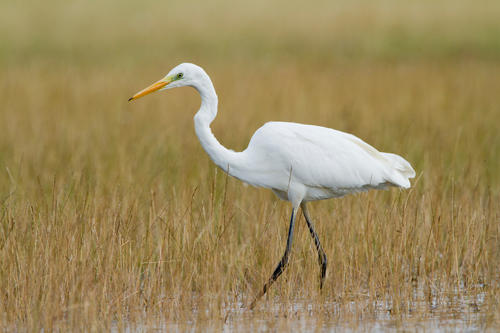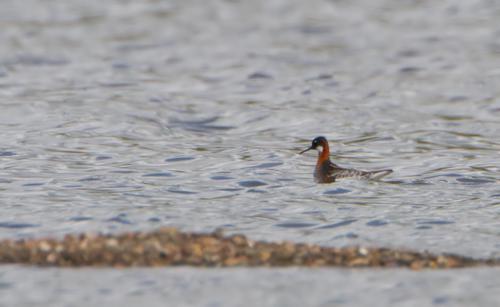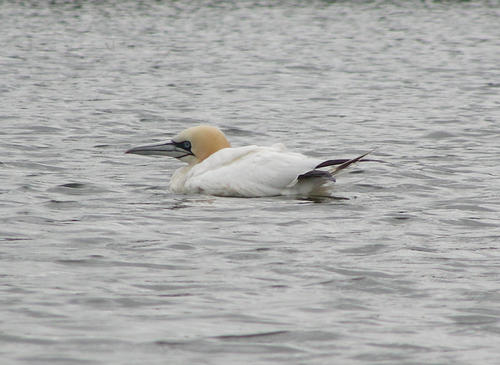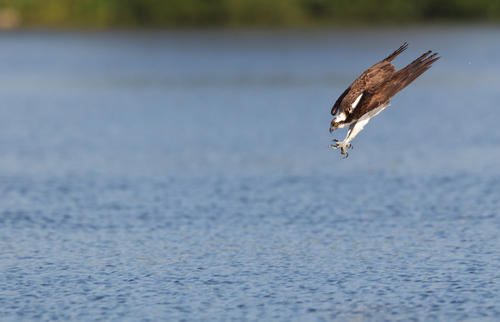Birds in Worcestershire – May to September 2012
Gavin Peplow
This summer has been virtually the wettest on record and certainly so in living memory. The few short brighter and warmer spells have been much appreciated, but in spite of (or on occasions perhaps due to) the weather, some interesting birds have been found.
Following April’s surprise influx, a further White Stork was seen in the Drakes Broughton area in late May, though this time a small ‘rubber’ ring was detected at the bottom of one of its legs, suggesting that it may have been of captive origin. Three Black-necked Grebes were at Bittell Reservoir for a day at the beginning of the month, with a further singleton there three weeks later. A drake Common Scoter also paused briefly at this site during the second week.
As is usual, May provided the bulk of the County’s wader highlights, albeit numbers are lower these days than a few years ago. Grimley attracted a wandering Avocet, parties of two and three Sanderling, a Little Stint and a Wood Sandpiper, with Lower Moor also visited by these last two species. A Bar-tailed Godwit lingered at Bittell for several days, with it or another, paying a short visit to Lower Park Farm to the north of Redditch. Late flooding at Longdon Marsh saw a peak of 16 Whimbrel drop in to feed, accompanied by a pair of Garganey. The star of the show though was a smart Red-necked Phalarope (Fig. 2.) which spent part of a day at Upton Warren before the regular forays of a local Peregrine encouraged it to move on - amazingly this is the fourth consecutive year that this species has visited the reserve!
A Sandwich Tern passed quickly through Bittell whilst two Black Terms were also seen there, with another reported over floodwater on the southern outskirts of Worcester.
A couple of Marsh Harriers drifted through Upton Warren, with the reserve also attracting a late Short-eared Owl at the start of the month, followed soon after by a passage Osprey.
A Nightingale sang from scrub near Diglis, Worcester for at least a couple of weeks and proved very popular and a couple of Quail calling late in the month at Woodrow and Honeybourne suggested that summer might finally be on its way!
Migration dwindled as June arrived, but a lingering Little Gull at Upton Warren was appreciated as was a Little Tern (by the few that saw it) that passed quickly through both there and Westwood. A party of 15 Crossbills on the Clent Hills were indicative of a small mid-year influx, whilst Red Kites continued to be seen frequently, with speculation that they should soon become a breeding species in the County (if this hasn’t in fact already happened!?)
The main event of June though, was an influx of Mediterranean Gulls to Upton Warren. Eleven were counted as being on site on one day at the end of the month with these birds lingering into July and at least 12 birds of varying ages involved in total. They were completely at home amongst the Black-headed Gull colony and one can only suspect that the display activity witnessed at this time is a pre-cursor to future breeding on the Reserve.
The persistent wet weather led to further flooding in the lower Severn and Avon valleys in early July and another four Mediterranean Gulls were seen amongst the large gathering of Black-heads at Bredon’s Hardwick. An adult Gannet (Fig. 3.) was found at Kemerton Lake at the start of the month, but sadly was sick and died overnight. Parties of three then two Common Scoter paused briefly at Upton Warren and two Sandwich Terns were detected calling as they flew over Kidderminster. The undoubted highlight of the whole summer however was an adult White-rumped Sandpiper that joined a Dunlin on receding floodwater at Grimley mid-month. Unfortunately for some it only stayed for a few hours one evening, but being only the second ever record for the County, it nevertheless attracted a lot of interest.
August began with a Great White Egret being located at Grimley (see www.carldayphotography.co.uk). (Fig. 1). It found the site much to its liking and stayed for a month, being joined by up to three Little Egrets at times. A Shag was also seen on one of the pits here briefly – a first record for the site. Several Black Terns passed through whilst the most interesting waders included individual Ruff at Longdon and Upton Warren, with a Spotted Redshank and a Knot also seen at this last site. A Wryneck was feeding on ants in a Stoulton garden towards the month end, whilst Marsh Harriers were seen over the two Nafford Reserves and at Upton Warren and an Osprey set up temporary residence at this last site into September (Fig. 4.).
The Great White Egret left Grimley in early September, but then presumably the same individual returned again 3½ weeks later. A Spotted Crake was found at Upton Warren Flashes one evening but then disappeared. A Sandwich Tern paused briefly at Grimley, as did a juvenile Marsh Harrier seen feeding on a dead Mute Swan there one evening. Up to four Garganey were equally elusive at this site, despite one bird lingering for ten days. Another Marsh Harrier, (perhaps the bird seen previously at Nafford) joined a spectacular gathering of at least 25 Buzzards and four Kestrels hunting rodents being disturbed during harvesting in a field near Bricklehampton in the second week.
The month concluded with three Common Scoter dropping in to Upper Bittell one afternoon and two Arctic Terns passing quickly through Bredon’s Hardwick.
Records compiled from reports received by Birdnews Midlands.
For all the latest information on birds currently within Worcestershire and the Midlands Region, call 09068-700247 (calls charged at 60p per minute).
Images
Fig.1. Great White Egret at Grimley. Carl Day
Fig.2. Red-necked Phalarope at Upton Warren.Peter Walkden
Fig.3. Gannet at Kemerton Lake. Brian Stretch
Fig.4. Osprey diving at Upton Warren. Alonza Garbett



